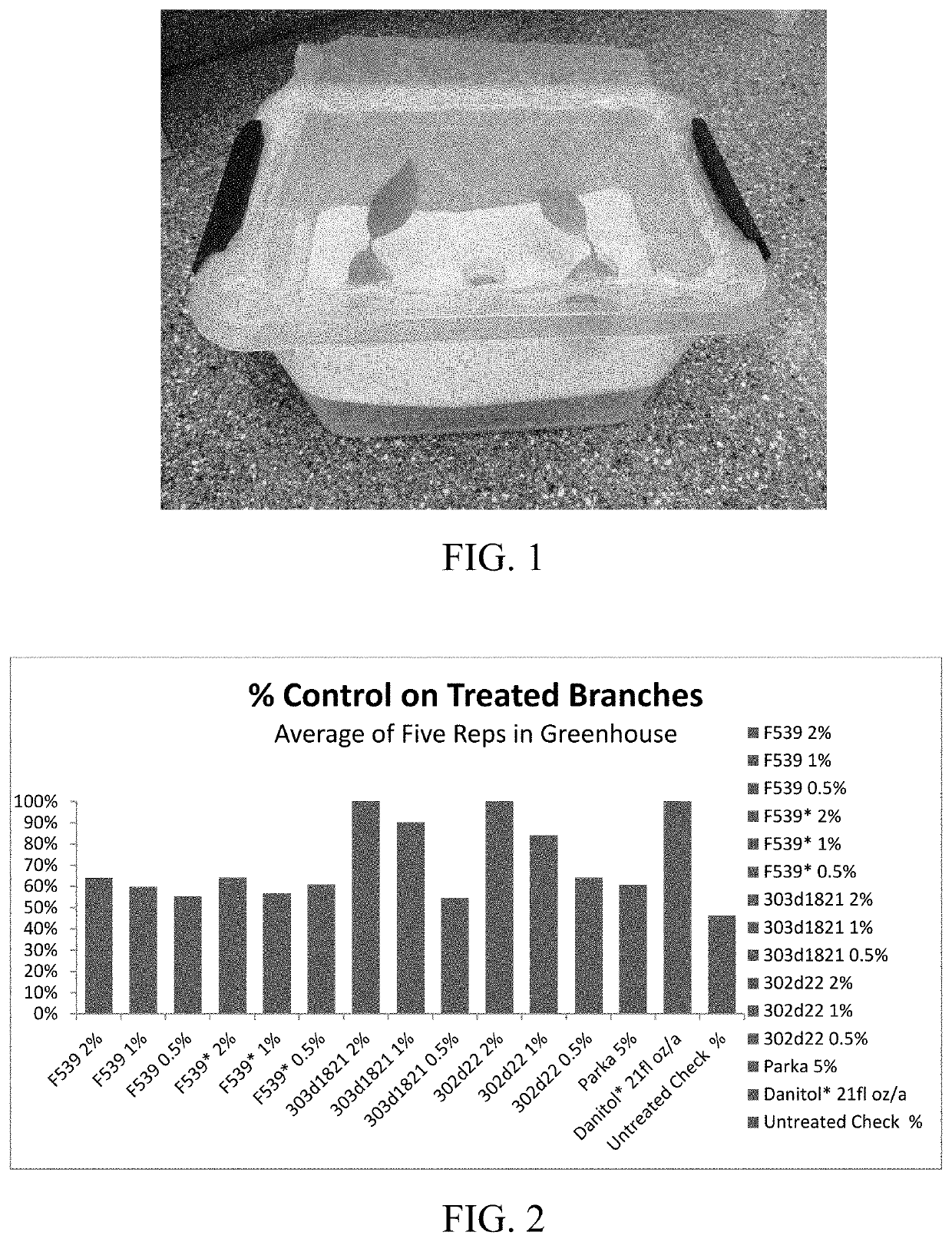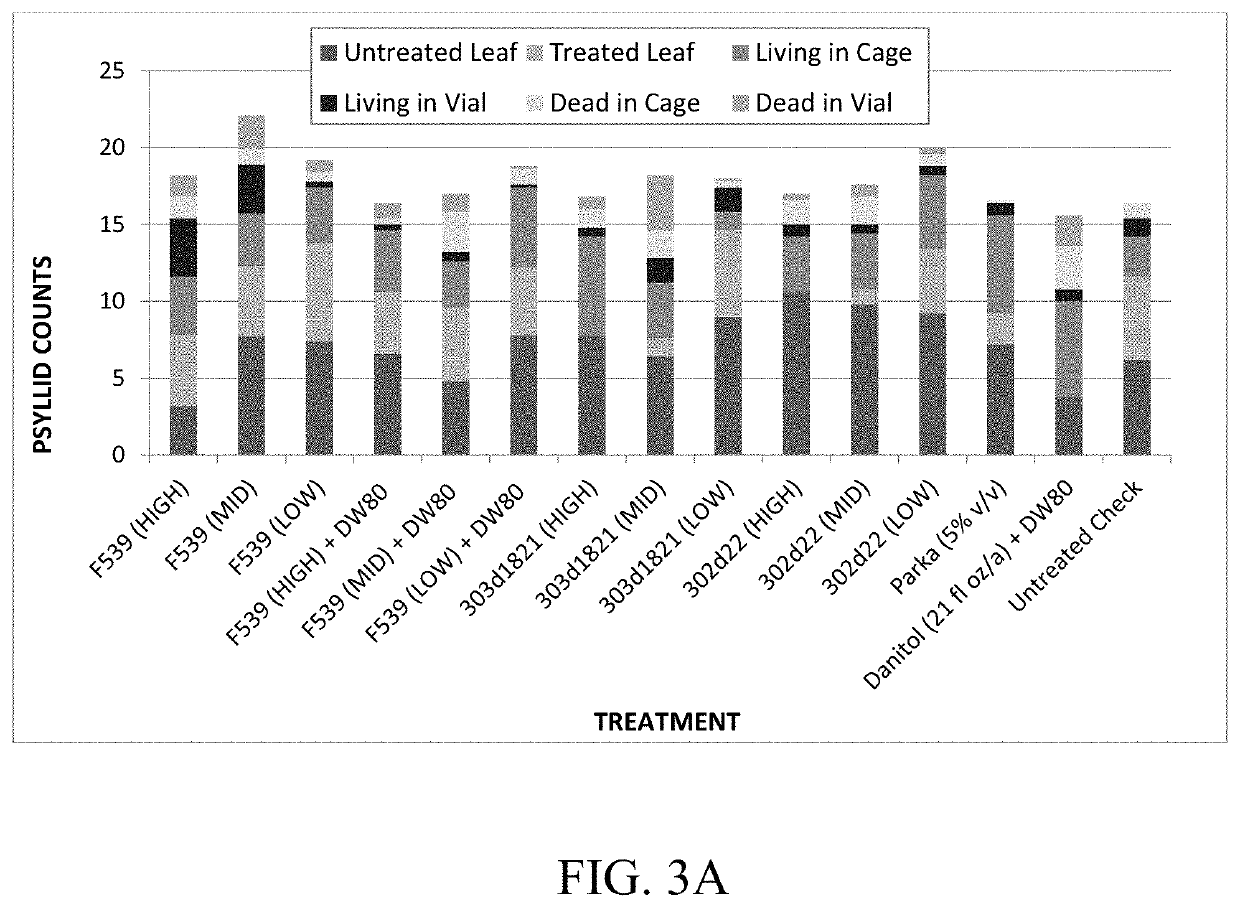Novel pest repellant formulations and uses thereof for crop protection
a technology of pest repellant and formulation, applied in the field of new pest repellant formulation, can solve the problems of high cost of chemical fertilizers and herbicides, affecting the health of the environment, and affecting the ability of farmers to maximize production yields,
- Summary
- Abstract
- Description
- Claims
- Application Information
AI Technical Summary
Benefits of technology
Problems solved by technology
Method used
Image
Examples
example 1
[0167]Development of insect repellent composition comprising anthranilate esters. Insect repellent composition comprising butyl anthranilate was developed according to the subject invention. For example, methyl or butyl anthranilate can be formulated in any of Formulae A-S.
TABLE 8Formulae A-DFormula AFormula BFormula CFormula DComponentsPercentagePercentagePercentagePercentageStearic Acid7.57.57.57.5Lecithin5.02.55.05Hypromellose (HPMC)0.01.0——Potassium Silicate1.01.01.01.0(29.1% solution)Isopropyl myristate———13.0Glycerin20.020.020.02.0Methyl parabens0.180.180.180.36Propyl parabens0.020.020.020.04Water66.365.364.369.1Carboxymethyl Cellulose——1.01.0Calcium Acetate——1.01.0
TABLE 9Formulae E-HFormula EFormula FFormula GFormula HComponentsPercentagePercentagePercentagePercentageStearic Acid7.57.57.5Glyceryl monostearate7.5Lecithin5.05.05Polyglyceryl-3-Oleate5.0Hypromellose (HPMC)0.01.0—Methylcellulose1.0Potassium Silicate1.01.01.0(29.1% solution)Aluminum magnesium1Silicate (30% solution...
example 2
Pest Repelling Effect
[0168]Pest repelling effect of compositions according to the subject invention was tested in choice assays. ACP were released in an arena and given a choice between treated and untreated shoots to determine how the repellent composition affects host selection and settling behavior.
[0169]Citrus shoot cuttings were inserted into wet floral foam fitted inside 33 ml clear polystyrene vials to maintain the integrity of the shoots. The vials were sealed using parafilm to prevent floral foam desiccation and psyllid access (FIG. 1).
[0170]The choice arena was designed to house three vial inserts. The center vial contained 20 psyllids for release while two peripheral vials held either treated or untreated shoot (FIG. 1).
[0171]The treatments are summarized in Table 13 below. The treatments include: 1) the composition of F539 (Butyl Anthranilate at 40%, Vansol 63 at 55%, and Toximul 3463F at 5%); 2) the composition of 302d22 (Ethyl anthranilate 10%); 3) Parka (composition a...
example 3
Young Citrus Tree Trial
[0176]OBJECTIVE: Test the phytoxic potential of the PARKA test-formulations with and without the active ingredient—Methyl Anthranilate (MA) repellent compound. Greenhouse testing at rates equivalent to expected field rates was conducted on young citrus trees (Valencia orange) in a greenhouse setting.
Materials:
[0177]Spray bottles for applications: (500m1 utility spray bottle with adjustable nozzle) 36 young Valencia citrus trees: Potted Valencia Orange trees, entry size 12″-18.″[0178]Flags or tape to mark treatments[0179]PPE: Eye, skin, inhalation (mist)
[0180]OPERATIONAL: Two repellant formulations were tested. Both formulations contained equal concentrations of Parka (20% v / v). The formulations vary in their concentrations of repellent: an original formulation with concentration of 20% v / v (MA-20), vs. a high concentration AI formulation containing a 40% v / v concentration (MA-40). Application rates are based on the concentration of repellent used in the final ...
PUM
 Login to View More
Login to View More Abstract
Description
Claims
Application Information
 Login to View More
Login to View More - R&D
- Intellectual Property
- Life Sciences
- Materials
- Tech Scout
- Unparalleled Data Quality
- Higher Quality Content
- 60% Fewer Hallucinations
Browse by: Latest US Patents, China's latest patents, Technical Efficacy Thesaurus, Application Domain, Technology Topic, Popular Technical Reports.
© 2025 PatSnap. All rights reserved.Legal|Privacy policy|Modern Slavery Act Transparency Statement|Sitemap|About US| Contact US: help@patsnap.com



